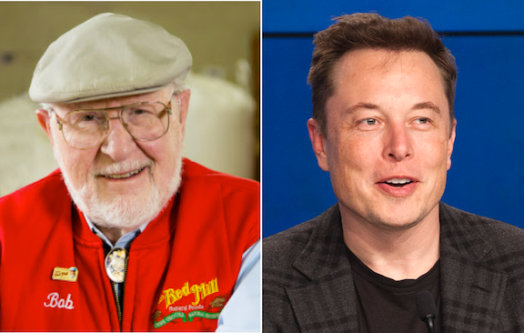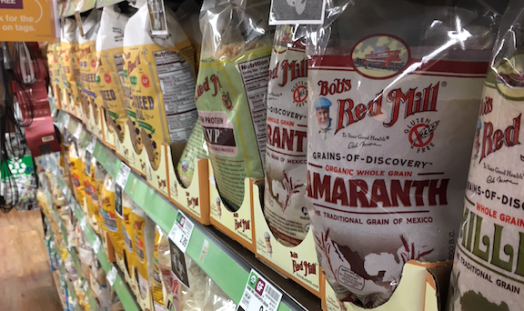I recently had a series of conversations about how the public perceives two brands that I find intriguing: Bob’s Red Mill, a natural foods producer based in Oregon, and Hyperloop, a platform for rapid long distance transportation that is being implemented by a number of organizations all over the world. I took some notes—and created this post.
To me, the common thread between Bob’s Red Mill and Hyperloop is that they both let the people behind them represent them. It makes their value propositions credible in a way that clever writing and a huge creative budget can’t.

Here’s a look at the values, origin story, and iconography of each.
Bob’s Red Mill
Values: Bob’s Red Mill is about security. People want to eat food that’s healthy as well as tasty. Bob’s Red Mill gives them that sense of trust, comfort, and satisfaction, because the people behind the brand believe in it themselves.
Origin Story: Bob was a do-it-yourself guy who wasn’t satisfied with how food was being mass produced in the 60s. How grain is ground seems like a small thing but makes a big difference. So he started grinding grain himself and, without intending to, he became a pioneer of the natural (and later organic and gluten free) foods movement. He acquired traditional grindstones and, along with his wife, started buying and grinding raw grain and selling it. This turned into a business. He overcame challenges, like rebuilding his mill after a fire burned it down, and acquiring enough stone grindstones to meet demand He tried to retire, twice, but couldn’t stay at home. After his company became a success, he transferred ownership to the employees, but still comes to work every day.
Iconography: The symbols of Bob’s Red Mill include Bob himself, the mill, the grindstones, and the grain itself. Pictures of Bob, and sometimes the mill or a stone grindstone, are on every package. Many packages include transparent areas so you can see what’s inside.

You can take a tour of the mill (my family has), where you can touch grains of many types and original grindstones. You can watch grain being ground and bagged, and see gluten-free products being processed and packaged in a separate room with an independent ventilation system to prevent contamination from products containing gluten. You may even meet Bob himself while you’re there (we did).

You can also eat at the Bob’s Red Mill cafeteria—featuring whole grains, naturally—where you may see Bob waiting in line like everyone else (we did). I spoke with a cashier-owner who has worked there for 17 years and can’t imagine doing anything else. From the supermarket to the factory floor, you can see and hear for yourself why you should trust this brand. Bob, and the employees who wear his mantle, are there looking out for your health and satisfaction.

Which just could be one of the reasons why I use Bob’s Red Mill products (particularly flour for breads and baking, and oatmeal) every week at home.
Hyperloop
Values: Hyperloop is all about speed. At 760 mph, travel by Hyperloop converts a Cleveland to Chicago commute from a five and a half hour ordeal of freeway driving, or four and a half hours via airplane, to a thirty minute ride in the equivalent of a private jet. But besides saving time, accelerating economic development, and the sheer excitement of moving so fast, Hyperloop is a bottoms-up, grassroots movement catching fire across the globe.
Origin story: Like Prometheus giving fire to humanity—or these days, more like Tony Stark gifting some cool new technology—Elon Musk ignited a crowd-sourced version of the space race in 2013 by announcing that he was open-sourcing the concept of Hyperloop. In a series of competitions judged (literally) by rocket scientists from SpaceX, teams of students and academics from universities and research institutions around the world began to create and test “capsules” for safely transporting humans through nearly airless Hyperloop tubes, propelled by linear induction. Cities, regions, and nations all over the world began partnering with pioneering Hyperloop builders, like the company Hyperloop TT, bringing together engineers, creatives, academics and other experts committed to building Hyperloop systems in Cleveland, Korea, the Czech Republic, Indonesia, Abu Dhabi, China, Slovakia, and elsewhere. By backing Hyperloop you are joining a world-wide community actively collaborating to create the future.
Iconography: In numerous media stories, social media posts and web pages, Hyperloop is emblemized by its spaceship-like capsules, traveling through futuristic tubes, connecting vast distances in minutes. And the imagery moves beyond technology. The ongoing series of capsule competitions feature images of incredibly smart engineering students and academics from all over the world demonstrating their innovative capsule prototypes.
Ambitious communities, regions, and nations join in the promotion with animations depicting how their Hyperloop projects will connect them to their neighbors.
Considering how unproven multiple aspects of the platform currently are (like the effects on human of high-G acceleration when—if? pods go around curves), it smacks of a gold rush. But it’s hard not to get swept up in the excitement—it truly appears to be the beginning of a global phenomenon. And the potential (even if freight-only pods wind up being the only ones that can go around curves) is mind-blowing. So I can’t help but be excited, and rooting for all of the people involved.
